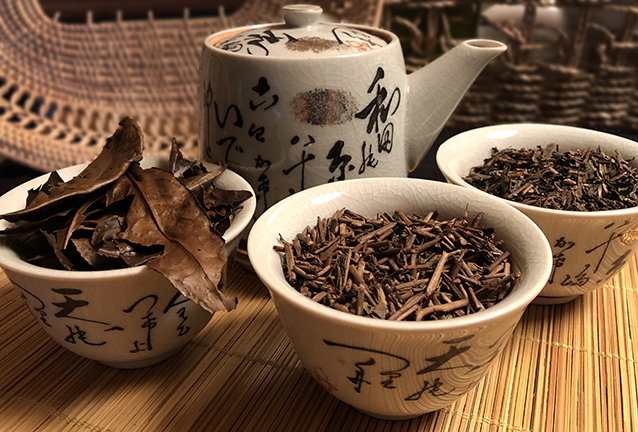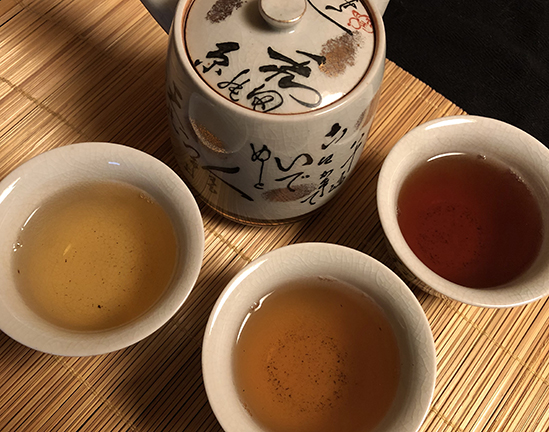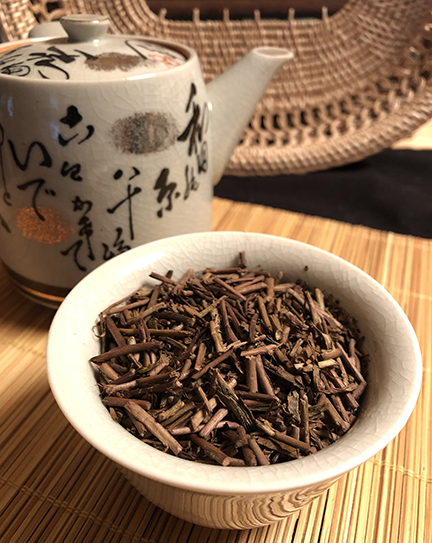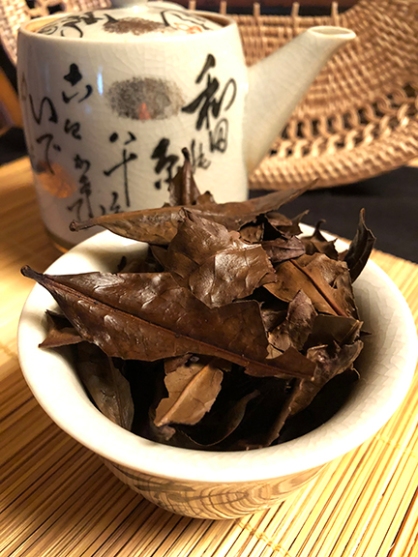Love Japanese green teas? Or hate them?
If you’re simply not a fan of the vegetal nature of steamed Japanese green teas—perhaps deeming them seaweed-y or even swampy—you really ought to at least try hojicha (or houjicha). You will find that it is quite different!
From the photo here, you can already see that these are not your ordinary green teas because these hojichas are indeed green teas despite their warm chocolatey colors!
 Hojicha: What It Is
Hojicha: What It Is
While many tea names apply to specific teas, hojicha refers to any roasted Japanese green tea, which means there are various types and grades of hojicha, depending on what tea—or part of tea leaf—was chosen to toast.
You can make hojicha out of whole leaves or pieces of leaves, stems and veins, or the fannings (tiny bits of tea) that go into tea bags.
To make hojicha, you start with green tea, which has been steamed to stop oxidation. (This is one of the major differences between Japanese and Chinese green teas; in China, oxidation is usually stopped by heating the leaves in woks.) The tea is put into a rotating drum, roasted at approximately 200°C (392°F), and then cooled.
Although this process means the final product runs from light to dark browns in color, yields a dark infusion, and has a toasty flavor profile, the tea is still considered a green tea. The roasting process sets off chemical changes in the tea leaves, reducing the caffeine level. Thus, hojicha—regardless of its base tea—has little bitterness and is low in caffeine. If the base tea consists of stems and veins, like the kuki hojicha pictured below, it has even less caffeine because caffeine is found primarily in the leaves.
The roasting process sets off chemical changes in the tea leaves, reducing the caffeine level. Thus, hojicha—regardless of its base tea—has little bitterness and is low in caffeine. If the base tea consists of stems and veins, like the kuki hojicha pictured below, it has even less caffeine because caffeine is found primarily in the leaves. This mild tea, then, is ideal for enjoyment by practically anyone, at any time of day or evening.
This mild tea, then, is ideal for enjoyment by practically anyone, at any time of day or evening.
Besides caffeine, catechins (polyphenols) also account for bitterness, flavor, and astringency in tea, along with the color of the infusion. Heat-converted catechins are found in matcha, sencha, bancha, and hojicha, with the highest levels in hojicha, but catechins in all their forms offer health benefits!
(Read more about catechins in an earlier post: Protective Power of Tea–3.)
Hojicha, like sencha, is a fairly new type of tea—at least on the centuries-long timeline of tea history! It was developed in the 1920s, in Kyoto, with charcoal as the source of heat. Its appealing aroma and ability to convert poor teas, or even the stems of the plant, into an enjoyable tea probably assured its success.
Hojicha: Made from Sencha and Bancha
Sencha constitutes some two-thirds of Japan’s tea, and runs the gamut from very high quality to a more everyday type of tea. The finest senchas are produced from the first harvest of leaves, which takes place in May. After sorting, the lesser quality of these leaves may be used to make a hojicha, but because these leaves are still first-flush tea, they make high-quality hojicha.
The second harvesting (June to July) can also be used for sencha production; these lower-quality leaves are more likely used for hojicha.
The second harvest also is used to produce bancha, a tea with a more subdued vegetal flavor than sencha. Unlike the small, tender leaves of the first harvest (or flush), the leaves have had more time to grow and so are larger.
Here you can see a leaf’s glossy top side and matte underside (bottom leaf), still evident after these bancha leaves have been roasted and made into hojicha. The third and fourth harvests yield more fibrous, hard leaves, which bring lower prices with their lesser quality and therefore are generally used for hojicha.
The third and fourth harvests yield more fibrous, hard leaves, which bring lower prices with their lesser quality and therefore are generally used for hojicha.
I tried some bancha hojicha grown and produced by Tsuchiyama in Koka, Shiga Prefecture (on the island of Honshu). This is the largest tea-producing area in the prefecture, both in cultivated area and in production volume. These huge, aromatic, dark olive green to brown leaves (also shown in closeup) brew up an infusion that is brownish yellow.
These huge, aromatic, dark olive green to brown leaves (also shown in closeup) brew up an infusion that is brownish yellow.

The earthy, toasty aroma, perhaps a bit reminiscent of grain or a freshly made slice of toast, foretells the flavor quite accurately! I found it didn’t matter how long I left the tea leaves in the liquid—the tea remained wonderfully pleasant.
So if green teas really aren’t your cup of tea, you just might find that this mild roasted tea actually IS!
NEXT POST: Kuki Hojicha
Sources:
Brekell, Per Oscar, The Book of Japanese Tea, Tankosha, 2018.
Saijo, R., and Y. Takeda, “HPLC analysis of catechins in various kinds of green teas produced in Japan and abroad,” Journal of the Japanese Society for Food Science and Technology (Japan), 1999.
Zavadckyte, Simona, Japanese Tea: A Comprehensive Guide, Kyoto Obubu Publishing House, 2017.

Houjicha’s a great tea! I was reading a textbook on Japanese tea and they also recommend houjicha for the evening (and for children and the elder who might be more caffeine sensitive) because of its low caffeine levels.
LikeLiked by 1 person